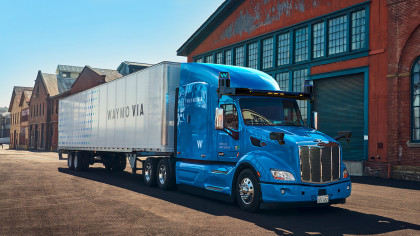May 8, 2020
Catching up with the Waymo Via trucking team


There’s a lot happening with Waymo Via trucking these days. Since we kicked off our goods delivery efforts in 2017, our self-driving trucks have been fixtures on freeways across California and Arizona, our technology has become even more advanced, and our trucking team has grown rapidly.
This week, members of our team had the chance to share the latest trucking updates at FreightWaves Live @ Home and on the What the Truck?!? and Autonocast podcasts. If you didn’t get to tune in live, check out some of the highlights below.
The versatility of the Waymo Driver
Our trucks use the same types of custom-built sensors and benefit from the same advanced software as our passenger vehicles, which helps us accelerate our trucking roadmap.
On the key differences between cars and trucks: “Trucks spend a lot more time on freeways and highways, which are higher-speed environments. They have a lot more mass, they're slower to accelerate and brake compared to passenger cars, and they have trailers, which can move semi-independently. We take into account the fact that our trucks need to be able to see further on the freeways and have different blind spots than the cars.” - Vijaysai Patnaik, Waymo’s Trucking Product Lead during FreightWaves Live @ Home
On our unique capability to tackle these differences: “The fact that our sensor suite for the ride-sharing business has gone through a number of generations is our great advantage. It has actually helped a lot because we're not developing sensors for the first time for trucking. We're leveraging many generations of the sensors that are designed to be mass producible and reliable to a degree that allows us to safely deploy a service. Building self-driving technology for passenger cars and for trucks aren't independent challenges. The more we make progress in one, it carries over really well into the other, and by working on both, we can actually get them to market faster.” - Boris Sofman, Waymo’s Trucking Engineering Lead in his chat with the Autonocast team
A gradual rollout in partnership with the industry
Commercial deployment of self-driving technology is going to be gradual, and we plan to work together with experts in the industry to bring our solution to market.
On partnering with key players: “The idea isn’t to disrupt the existing ecosystem of OEMs, Tier 1s, drivers, maintenance partners and the whole trucking industry,” Vijaysai explains. “It's about how we can partner with them. Because at its core, Waymo is a technology company. Our focus is on building the Waymo Driver, the self-driving technology that can enable safe and efficient movement of goods. And so, we want to work with folks who are already best at what they do and bring this technology to market.”
Boris also touched on the importance of partnerships: “We're very hands-on with partners and potential future customers,” he shared with the hosts of Autonocast. “We partner to better understand where the value proposition is and what are the highest value technical areas for us to push on that will most help us get to the commercialization path that we're on.”
On where we are now and what to expect ahead: “We are still solidly in the testing phase, where we are designing a solution in partnership with the industry, and it’s coming in the next several years. You’ll see certain use cases, certain types of fleets, certain geographies, and certain routes deployed much sooner. It’s not going to be an overnight transition.” - Charlie Jatt, Waymo’s Trucking Commercial Lead, who spoke on FreightWaves’ What the Truck?!? podcast
Ensuring safety and redundancy now and in the future
At Waymo, safety is at the core of our mission as we develop the Waymo Driver.
On the need for redundancies: Vijaysai detailed that “Even if there is a system failure, the self-driving truck [must be] able to either safely continue operating or come to a safe stop.” He follows on that this “requires redundancies in various parts of the system, whether that's braking, steering, power systems, the computer, or sensors. We developed multiple generations of passenger cars with that redundancy, and these cars are capable of L4 autonomy for these driverless operations.”
Charlie also gave an update on where the trucking industry stands on redundancies now: “Candidly, [the trucking industry] is a bit behind what we’ve seen on the passenger car side, and that’s really a reflection of where the autonomous sector has been on passenger cars versus trucks; we’ve been very pleased with how the ecosystem is rallying around the needs for redundancy.”
On taking the long-term safety view: “At Waymo, every type of safety condition you could imagine, across both cars and trucks, there’s thought put into it. Waymo is taking a long-term view and isn’t trying to sprint to the next checkpoint. We take a very safe approach to every one of our challenges.” Boris explained.
“At Waymo, we take a long-term view, so COVID-19 is obviously what is on everyone’s mind right now,” Charlie notes, “but we’re definitely focused on the long-term potential of our technology to make our roads safer across all modes of transportation.”

